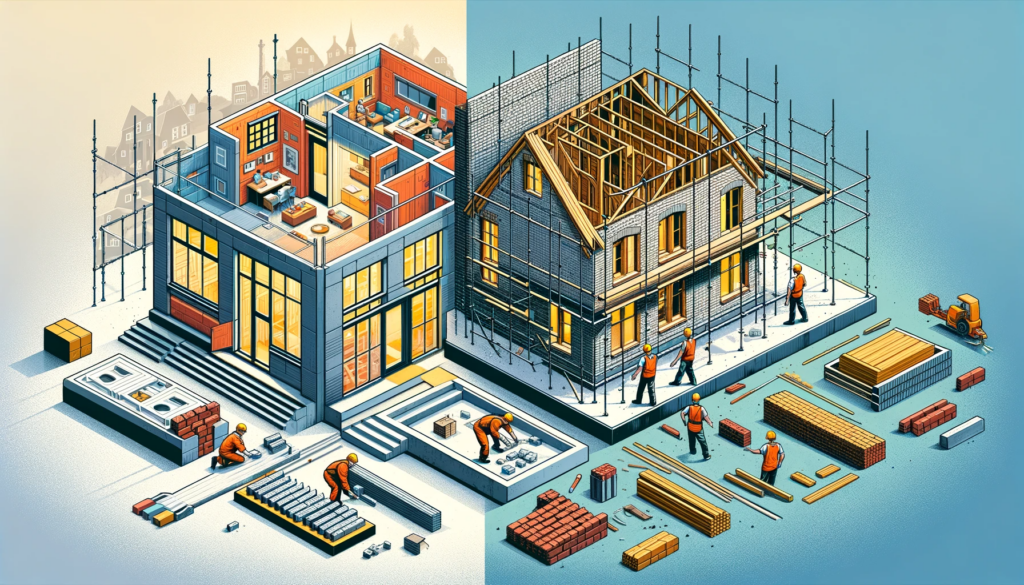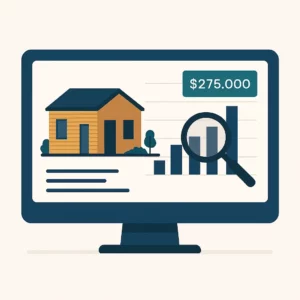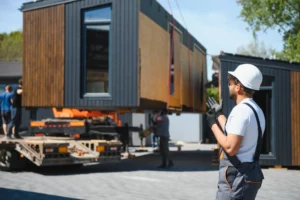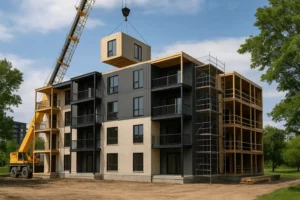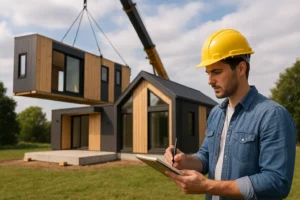Considering building your dream home involves a significant decision from the outset: whether to opt for a traditional construction method or opt for a prefabricated solution. This distinction is not trivial, as it influences the construction process, budget, timelines, and environmental impact of your project.
To guide you through this crucial decision, this article aims to highlight the key differences between traditional construction and prefabrication. Our goal is to provide you with all the information you need to make an informed choice, aligned with your expectations, specific needs, and vision of the ideal home.
Advantages and disadvantages
| Criteria | Traditional Construction | Prefabricated Construction |
|---|---|---|
| Process | Progressive construction on the site. | Rapid assembly of components in the factory. |
| Flexibility | Custom models or customizable plan. | Custom models or customizable plan. |
| Cost | Higher due to loss of efficiency and longer lead times. | More economical due to shorter manufacturing times, less waste and standardized and controlled manufacturing processes. |
| Time limit | Longer, because it is subject to climatic conditions and the work is carried out in non-ergonomic and non-optimal conditions. | Faster, because manufacturing is carried out on a production line, in a factory protected from the elements and at ergonomic workstations. |
| Personalization | 100% customizable. | 100% customizable. |
| Quality | Exposed to the elements during construction, higher risk of errors. | Materials protected from the elements throughout construction, assembled in an optimal and ergonomic environment. |
| Sustainability | Depends on materials, manufacturing quality, and maintenance. Life expectancy exceeds 100 years if well maintained. | Depends on manufacturing quality, maintenance, and materials. Lifespan also exceeds 100 years if well maintained. |
| Ecological Impact | Higher due to on-site waste management and material transportation. Less optimization possible in the use of materials and energy. | Reduced waste, more energy efficient, reduced transportation of prefabricated modules. Optimized energy and materials in the factory. |
| Innovations | Limited by traditional techniques, but adapted to specific projects. | Advantages of modern technologies, easy integration of ecological solutions, standardized production and continuous improvement. |
| Adaptability | 100% adaptable. | 100% adaptable. |
Construction process
Traditional construction
Although often perceived as offering extensive customization, traditional construction is distinguished more by its sequential and on-site method.
Each construction phase follows a precise order, directly on the ground.
While this approach allows for some adaptations during production, it requires meticulous coordination between craftsmen and can be subject to climatic hazards, thus risking extending delivery times.
Prefabricated construction
In contrast, prefabricated construction is characterized by its efficiency and precision.
The house elements are designed and pre-assembled in the factory under controlled conditions, before being transported and assembled on the final site.
This methodology eliminates weather variability on the construction schedule and can deliver consistent quality through manufacturing in a controlled environment.
In addition, it is now possible to customize a prefabricated house at 100%, or simply choose an existing model and adapt it to your needs.
Cost and time
- Traditional : May be more expensive and time-consuming, due to manual work and unforeseen events on site.
- Prefabricated : Generally more economical and faster, thanks to factory standardization. According to Profab, a prefabricated project could be almost 2x faster than on-site construction.
Personalization
Whether you choose traditional or prefabricated construction, it is essential to know that both methods now offer the ability to customize 100%, tailored to the specific wants and needs of each homeowner.
Flexibility in design and layout is at the heart of both approaches, allowing unlimited creative expression to bring your dream home to life.
Traditional : This approach is distinguished by its ability to adapt entirely to your preferences, from the initial plan to the finishing touches.
Through close collaboration with architects and builders, every aspect of your home can be customized to reflect your unique vision, with no constraints other than those imposed by local regulations.
Prefabricated Long perceived as less flexible, prefabricated construction has evolved considerably to offer complete customization. Technological advances and innovative design processes now make it possible to choose from a wide range of modular designs and adapt them to your tastes.
It is even possible with several manufacturers to have access to their architectural service in order to design your custom house.
From the overall structure to the interior details, the possibilities for customization are now as vast as in traditional construction, ensuring that your prefabricated home is just as unique and tailored to your aspirations.
Sustainability and quality
Whether through traditional or prefabricated methods, high standards of quality and durability can be achieved, especially when the use of premium materials and meticulous planning are prioritized. This demand for quality is demonstrated through the careful selection of materials, attention to detail during design, and rigorous monitoring throughout the construction process.
As part of a traditional construction, quality and durability are ensured through a bespoke construction process, where each element is selected and implemented according to the exact specifications of the project. The personalized approach allows for great attention to detail and adaptation to specific site conditions, thus contributing to the longevity of the work.
For constructions prefabricated, the advantage lies in the rigorous quality control in the factory, where manufacturing conditions are optimized and materials are protected from the elements. This method ensures uniformity and precision that are difficult to match on a traditional construction site. In addition, the efficiency of prefabrication often allows for the incorporation of innovations in sustainability and energy efficiency early in the design process.
So, regardless of the method chosen, by focusing on high-end materials and careful execution, it is entirely possible to create a habitat that stands out for both its superior quality and its exceptional durability.
Environmental impact
